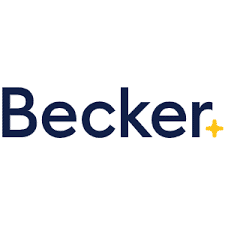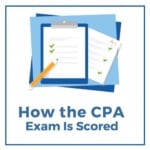The Financial Accounting and Reporting (FAR) test is one of four CPA exam sections (along with AUD, REG, and BEC). Out of the four, this CPA exam section is the most time-consuming to prepare for. That’s because FAR requires more calculations that any other test. Consequently, exam candidates may find it difficult to finish FAR in the time allowed.
Here’s some FAR CPA exam tips to help you can better prepare yourself for the test and hopefully avoid encountering the same issues as countless CPA candidates in the past.
This discussion explains the format of the FAR test, key test tips that will help you answer a large number of questions, and provides some guidance on creating a study plan.
If you’re studying for the FAR test and starting to feel overwhelmed, read on. We’ve got your back!
See the Top CPA Review Courses
- 1. Becker CPA Review Course ◄◄ Endorsed by Big 4 Accounting Firms + Save $1,330
- 2. Surgent CPA Prep Course ◄◄ Best Adaptive Technology
- 3. Gleim CPA Study Materials ◄◄ Largest CPA Test Bank

FAR CPA Exam Format
The CPA Exam includes four tests; candidates have four hours to take each one, including FAR. As the AICPA explains: “Each of the four exam sections is broken down into five smaller sections called testlets. These testlets feature multiple-choice questions (MCQs) and task-based simulations (TBSs).”
The AICPA also points out that “You will receive at least one research question (research-oriented TBS) in the AUD, FAR and REG sections. To complete them, you will have to search the related authoritative literature and find an appropriate reference.”
Ultimately, preparing for the FAR test requires the most study time, and the questions in this section are the most complicated. Hence, you need to place considerable emphasis on FAR concepts during your CPA review. With or without a review course, failing to properly cover these concepts will prevent you from finishing the FAR section accurately and in the allotted time period.
FAR CPA Exam Questions
The most effective method of exam study for the FAR exam is to start with topics that are frequently tested. The conceptual framework listed below will assist you; additionally, you may see multiple questions on each of these topics.
Study these topics so you can quickly answer these types of questions and pass FAR with a high exam score!
Earnings per share
Earnings per share (EPS) is heavily tested on this section of the CPA exam. This is because this ratio is the most common metric used for valuing a business. Furthermore, there are several ways to present EPS in financial reporting; those methods will likely appear on your FAR test.
Here’s the formula for basic earnings per share:
(Earnings per common share) / (Weighted average common stock shares outstanding)
Simply put, EPS reports that dollar amount of company earnings per share of common stock. Additionally, increasing earnings per share makes a firm more valuable to investors.
Now, you’ll note that EPS applies to common stock. Earnings that must be paid to preferred stock shareholders are excluded from the calculation.
Furthermore, the formula also uses weighted average common stock shares outstanding. Exam candidates are often asked to calculate the weighted average shares based on changes that occur during the year.
A second version of EPS is diluted earnings per share. Diluted EPS assumes that any securities that can be converted into common stock shares are converted and the number of shares increases. You can think of diluted EPS as a “what-if” ratio; this metric is used frequently in financial analysis.
The FAR test may give you information on a group of securities and ask you to perform the diluted EPS calculation. Here are some securities that can be converted into common stock:
- Stock options, rights, and warrants
- Convertible preferred stock
- Convertible bonds
The key to computing diluted EPS is to understand the number of common shares each security can produce and use those shares in the EPS calculation.
Finally, note that common stock shares outstanding will decline if the company purchases treasury stock.
FAR exam tips – Stock options
Stock options are considered to be derivatives: securities that are valued based on another security. Consequently, the value of a stock option depends on the value of the underlying common stock.
FAR content areas cover several types of derivatives. However, stock options are the most common.
One reason why businesses issue stock options is to provide an employee benefit, including for senior management, and provide an incentive to stay with the firm. Here’s an example:
Julie is the VP of Sales. Her firm awards her options on 500 shares of stock at an exercise price of $30 per share. The current market price of the stock is $22.
[uam_ad id=”7978″]
The logic of issuing stock options is to reward key employees who stay with the firm, and help the business produce better financial results.
If the company does well and the market price of the stock trades above $30 per share, Julie can exercise her options, buy shares at $30 and sell them at the higher market price. At a market price of $55, for example, Julie could use the options to purchase 500 shares at $30, and sell them for $55. Alternatively, she can also hold the shares and sell them at a later date.
Ultimately, the aforementioned purpose of stock options, and options calculations, are frequently covered on the FAR test.
Learn More About The CPA Exam
- How To Become A CPA
- CPA Exam Stats and Facts
- Best Order To Take CPA Exam
- Motivational Songs For Studying
Inventory valuation methods questions on the FAR test
Inventory is often the largest asset on the balance sheet, and inventory topics are covered on every FAR test. Furthermore, inventory valuation methods make up a large portion of this question set.
Here’s what you need to know about this topic:
When inventory is sold, the dollar amount is transferred from an asset account (inventory) to an expense account (cost of goods sold). As a result, the valuation method impacts when expenses are recognized for inventory sales in financial statements.
Here are the three most important valuation methods:
- FIFO: FIFO, or First-in, first out, means that the oldest inventory items are sold first.
- LIFO: LIFO, or Last-in, first out, means that the newest inventory items are sold first.
- Weighted Average: As the name implies, weighted average takes the total inventory cost and divides the amount by the total number of items in inventory.
Here’s a key point about valuation methods: the differences are only due to the timing of the expense. Basically, all three methods assume that the total cost of the units are the same and that the number of units sold is identical.
Assume, for example, that a retailer sells 100 dining room tables in March. The FIFO method assumes that the older (and usually cheaper) inventory items are sold first. LIFO, on the other hand, assumes that the newer (more expensive) units are sold first.
FIFO and LIFO will generate a different cost of goods sold total in the short term. However, once all of the inventory items are sold, the total cost will be the same for each valuation method.
Get Discounts On CPA Review Courses!

Extended Sale – Get $1,330 Off Becker CPA Pro

Take $1,110 Off Surgent CPA Ultimate Pass

Enjoy $1,000 Off Gleim CPA Premium Pro
CPA FAR Practice Exams
This bears repeating:
The FAR test requires the most study time to pass of the CPA exam tests. Additionally, how you spend that time is critically important. You’ll probably spend the bulk of your CPA review course hours working practice exams. Therefore, using these tips will help you know how to study for the CPA exam effectively when doing so.
Use the AICPA practice exams
Most CPA candidates purchase study materials that offer practice exams that effective mimic TBS testlets and MCQ testlets. While these are incredibly helpful resources to pull from, don’t forget that the AICPA offers some free sample tests as well. Use this free resource to better prepare yourself for the FAR and other sections of the CPA exam.
Get clarity about exam concepts
As you get closer to taking a particular test, you may start retaking practice exams. Furthermore, you may even feel frustration about seeing the same questions over and over again.
Keep in mind that your first priority is to understand the material; hence, you need to obtain clarity about any questions that you miss on a practice exam. Reinforcing concepts is more important than simply plowing through more practice questions. It’s all about quality over quantity!
Have Confidence in Your Plan
The sheer amount of material on the FAR test can make the study process feel overwhelming, but don’t panic! If you put a plan in motion and stick to it, you can nail down all the important concepts and pass the FAR test.
Use these tips to study for the FAR test with confidence, and to help you in passing the CPA exam. We believe in you!
COMPARE THE BEST CPA REVIEW COURSES
Helpful tips for CPA Exam Students:
- Make sure you have caffeine, or whatever else you find helps you focus and gives you energy.
- Get a quick workout or exercise in to boost your blood flow and ultimately your mental focus and energy.
- During the exam, flag the multiple choice questions that you find hard or don’t know.
- Simulations are a big part of the exam, try to enjoy them!
Frequently Asked Questions About The FAR CPA Exam
How long should you study for FAR CPA?
Typically, it’s recommended that accounting students devote between 300-400 hours on cumulative exam study. And because FAR is considered the most difficult portion of the CPA exam, it’s a good idea to spend at least 100 of those study hours on this portion of the test.
Which is the hardest part of the CPA exam?
Most CPA exam takers say that the most difficult portion of the test is Financial Accounting and Reporting (FAR). This section of the test involves several complicated accounting concepts and has the lowest pass rates out of all four sections according to data from the AICPA.
How do I pass the FAR CPA exam?
Because this portion of the CPA exam involved financial reporting, you should focus your study schedule around understanding these concepts. Fortunately, many of the best CPA exam review courses organize their study materials to make this easy to accomplish.
How hard is the FAR CPA exam?
Your mileage may vary when taking the Financial Accounting and Reporting section of the CPA exam, but most students say that it’s the toughest part of the entire test. According to the AICPA, this is also the section with the lowest pass rates— so you definitely want to study hard in order to pass this section!










